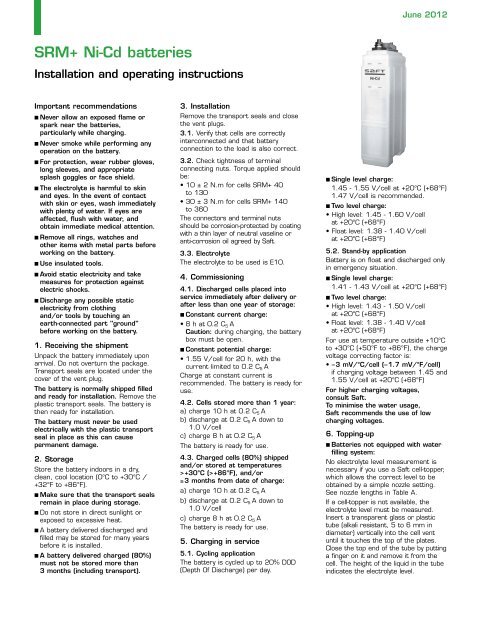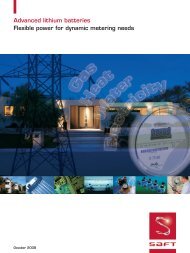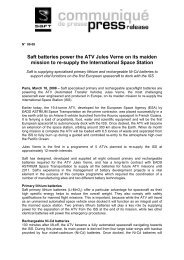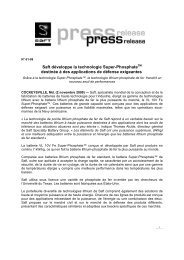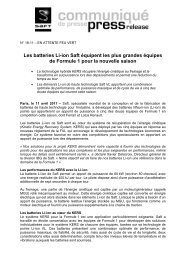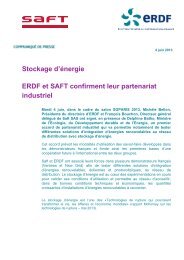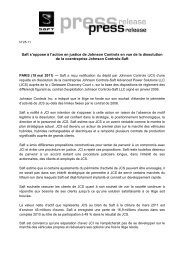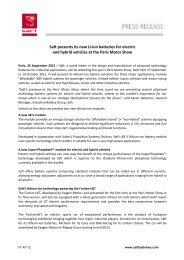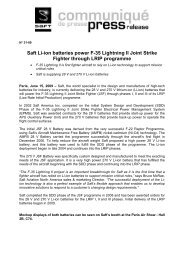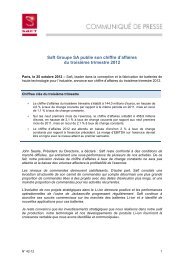SRM+ Ni-Cd batteries - Saft
SRM+ Ni-Cd batteries - Saft
SRM+ Ni-Cd batteries - Saft
Create successful ePaper yourself
Turn your PDF publications into a flip-book with our unique Google optimized e-Paper software.
June 2012<br />
<strong>SRM+</strong> <strong>Ni</strong>-<strong>Cd</strong> <strong>batteries</strong><br />
Installation and operating instructions<br />
Important recommendations<br />
■ Never allow an exposed flame or<br />
spark near the <strong>batteries</strong>,<br />
particularly while charging.<br />
■ Never smoke while performing any<br />
operation on the battery.<br />
■ For protection, wear rubber gloves,<br />
long sleeves, and appropriate<br />
splash goggles or face shield.<br />
■ The electrolyte is harmful to skin<br />
and eyes. In the event of contact<br />
with skin or eyes, wash immediately<br />
with plenty of water. If eyes are<br />
affected, flush with water, and<br />
obtain immediate medical attention.<br />
■ Remove all rings, watches and<br />
other items with metal parts before<br />
working on the battery.<br />
■ Use insulated tools.<br />
■ Avoid static electricity and take<br />
measures for protection against<br />
electric shocks.<br />
■ Discharge any possible static<br />
electricity from clothing<br />
and/or tools by touching an<br />
earth-connected part "ground"<br />
before working on the battery.<br />
1. Receiving the shipment<br />
Unpack the battery immediately upon<br />
arrival. Do not overturn the package.<br />
Transport seals are located under the<br />
cover of the vent plug.<br />
The battery is normally shipped filled<br />
and ready for installation. Remove the<br />
plastic transport seals. The battery is<br />
then ready for installation.<br />
The battery must never be used<br />
electrically with the plastic transport<br />
seal in place as this can cause<br />
permanent damage.<br />
2. Storage<br />
Store the battery indoors in a dry,<br />
clean, cool location (0°C to +30°C /<br />
+32°F to +86°F).<br />
■ Make sure that the transport seals<br />
remain in place during storage.<br />
■ Do not store in direct sunlight or<br />
exposed to excessive heat.<br />
■ A battery delivered discharged and<br />
filled may be stored for many years<br />
before it is installed.<br />
■ A battery delivered charged (80%)<br />
must not be stored more than<br />
3 months (including transport).<br />
3. Installation<br />
Remove the transport seals and close<br />
the vent plugs.<br />
3.1. Verify that cells are correctly<br />
interconnected and that battery<br />
connection to the load is also correct.<br />
3.2. Check tightness of terminal<br />
connecting nuts. Torque applied should<br />
be:<br />
• 10 ± 2 N.m for cells <strong>SRM+</strong> 40<br />
to 130<br />
• 30 ± 3 N.m for cells <strong>SRM+</strong> 140<br />
to 360<br />
The connectors and terminal nuts<br />
should be corrosion-protected by coating<br />
with a thin layer of neutral vaseline or<br />
anti-corrosion oil agreed by <strong>Saft</strong>.<br />
3.3. Electrolyte<br />
The electrolyte to be used is E10.<br />
4. Commissioning<br />
4.1. Discharged cells placed into<br />
service immediately after delivery or<br />
after less than one year of storage:<br />
■ Constant current charge:<br />
• 8 h at 0.2 C 5 A<br />
Caution: during charging, the battery<br />
box must be open.<br />
■ Constant potential charge:<br />
• 1.55 V/cell for 20 h, with the<br />
current limited to 0.2 C 5 A<br />
Charge at constant current is<br />
recommended. The battery is ready for<br />
use.<br />
4.2. Cells stored more than 1 year:<br />
a) charge 10 h at 0.2 C 5 A<br />
b) discharge at 0.2 C 5 A down to<br />
1.0 V/cell<br />
c) charge 8 h at 0.2 C 5 A<br />
The battery is ready for use.<br />
4.3. Charged cells (80%) shipped<br />
and/or stored at temperatures<br />
>+30°C (>+86°F), and/or<br />
≥3 months from date of charge:<br />
a) charge 10 h at 0.2 C 5 A<br />
b) discharge at 0.2 C 5 A down to<br />
1.0 V/cell<br />
c) charge 8 h at 0.2 C 5 A<br />
The battery is ready for use.<br />
5. Charging in service<br />
5.1. Cycling application<br />
The battery is cycled up to 20% DOD<br />
(Depth Of Discharge) per day.<br />
■ Single level charge:<br />
1.45 - 1.55 V/cell at +20°C (+68°F)<br />
1.47 V/cell is recommended.<br />
■ Two level charge:<br />
• High level: 1.45 - 1.60 V/cell<br />
at +20°C (+68°F)<br />
• Float level: 1.38 - 1.40 V/cell<br />
at +20°C (+68°F)<br />
5.2. Stand-by application<br />
Battery is on float and discharged only<br />
in emergency situation.<br />
■ Single level charge:<br />
1.41 - 1.43 V/cell at +20°C (+68°F)<br />
■ Two level charge:<br />
• High level: 1.43 - 1.50 V/cell<br />
at +20°C (+68°F)<br />
• Float level: 1.38 - 1.40 V/cell<br />
at +20°C (+68°F)<br />
For use at temperature outside +10°C<br />
to +30°C (+50°F to +86°F), the charge<br />
voltage correcting factor is:<br />
• –3 mV/°C/cell (–1.7 mV/°F/cell)<br />
if charging voltage between 1.45 and<br />
1.55 V/cell at +20°C (+68°F)<br />
For higher charging voltages,<br />
consult <strong>Saft</strong>.<br />
To minimise the water usage,<br />
<strong>Saft</strong> recommends the use of low<br />
charging voltages.<br />
6. Topping-up<br />
■ Batteries not equipped with water<br />
filling system:<br />
No electrolyte level measurement is<br />
necessary if you use a <strong>Saft</strong> cell-topper,<br />
which allows the correct level to be<br />
obtained by a simple nozzle setting.<br />
See nozzle lengths in Table A.<br />
If a cell-topper is not available, the<br />
electrolyte level must be measured.<br />
Insert a transparent glass or plastic<br />
tube (alkali resistant, 5 to 6 mm in<br />
diameter) vertically into the cell vent<br />
until it touches the top of the plates.<br />
Close the top end of the tube by putting<br />
a finger on it and remove it from the<br />
cell. The height of the liquid in the tube<br />
indicates the electrolyte level.
<strong>SRM+</strong> <strong>Ni</strong>-<strong>Cd</strong> <strong>batteries</strong><br />
Level (mm)<br />
high low<br />
<strong>SRM+</strong> 40 to 130 50 5<br />
<strong>SRM+</strong>140 to 360 65 5<br />
■ Batteries equipped with water filling<br />
system:<br />
• Remove transport seals and connect<br />
hydraulic tubing between cells up to<br />
a maximum of 50 cells.<br />
• Make sure that the tubes are<br />
completely inserted for a good seal.<br />
• The hydraulic connection of cells<br />
must be in parallel to the electrical<br />
connection, in order to avoid<br />
voltage differences of more than<br />
1.2 V between two hydraulically<br />
connected cells.<br />
• The hydraulic connection must be<br />
horizontal in order to avoid siphoning.<br />
• The water filling circuit output must<br />
not be too close to electrical<br />
equipment, electrical circuit, and<br />
metallic structure.<br />
• Water filling circuit input must be<br />
connected to the self closing inlet.<br />
• Topping-up can be performed by<br />
gravity or using adapted pump with a<br />
flow rate of 0.7 l/min at a relative<br />
pressure of 0.3 bar maximum.<br />
Table A:<br />
Capacity Charge current Length of cell<br />
Cell type C 5 Ah 0.2 C 5 A topper nozzle<br />
(Ah) (A) (mm)<br />
<strong>SRM+</strong> 40 40 8,0 65<br />
<strong>SRM+</strong> 70 70 14,0 65<br />
<strong>SRM+</strong> 80 80 16,0 65<br />
<strong>SRM+</strong> 90 90 18,0 65<br />
<strong>SRM+</strong> 100 100 20,0 65<br />
<strong>SRM+</strong> 120 120 24,0 65<br />
<strong>SRM+</strong> 130 130 26,0 65<br />
<strong>SRM+</strong> 140 140 28,0 70<br />
<strong>SRM+</strong> 160 160 32,0 70<br />
<strong>SRM+</strong> 180 180 36,0 70<br />
<strong>SRM+</strong> 200 200 40,0 70<br />
<strong>SRM+</strong> 220 220 44,0 70<br />
<strong>SRM+</strong> 240 240 48,0 70<br />
<strong>SRM+</strong> 260 260 52,0 70<br />
<strong>SRM+</strong> 280 280 56,0 70<br />
<strong>SRM+</strong> 300 300 60,0 70<br />
<strong>SRM+</strong> 320 320 64,0 70<br />
<strong>SRM+</strong> 360 360 72,0 70<br />
7. Periodic maintenance<br />
■ Maintenance operations (not<br />
including the topping-up operation):<br />
Periodic maintenance should be<br />
carried out every two years.<br />
• Keep the battery clean using only<br />
water. Do not use a wire brush or<br />
solvents of any kind. Vent plugs can<br />
be rinsed in clean water when dirty.<br />
• Check that all connectors are tight.<br />
Coat with grease or neutral vaseline<br />
all terminal nuts and cell connectors.<br />
• Check charger settings. It is of great<br />
importance that the recommended<br />
charging voltage remains unchanged.<br />
High water consumption of the<br />
battery is usually caused by improper<br />
voltage setting of the charger.<br />
■ Topping-up operation:<br />
Check the electrolyte level. Never let<br />
the level fall below the minimum level<br />
mark. Use only distilled or deionized<br />
water to top-up.<br />
Frequency of topping-up must be<br />
determined for each battery.<br />
It depends on charging voltage and<br />
real utilization of the battery. Refer<br />
to section 6 concerning topping-up.<br />
8. Changing electrolyte<br />
Due to the sintered electrode plastic<br />
bonded technology, it is not necessary<br />
to change the electrolyte during the life<br />
time of the cells.<br />
9. Environment<br />
To protect the environment all used<br />
<strong>batteries</strong> must be recycled.<br />
Contact your local <strong>Saft</strong> representative<br />
for information.<br />
<strong>Saft</strong><br />
Industrial Battery Group<br />
12, rue Sadi Carnot<br />
93170 Bagnolet - France<br />
Tel: +33 1 49 93 19 18<br />
Fax: +33 1 49 93 19 64<br />
www.saft<strong>batteries</strong>.com<br />
Doc N° 21845-2-0612<br />
Data in this document is subject to change without<br />
notice and becomes contractual only after written<br />
confirmation.<br />
Société par Actions Simplifiée<br />
au capital de 31 944 000 <br />
RCS Bobigny B 383 703 873<br />
Le Révérend Imprimeur - Printed in France - 2k


